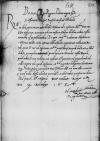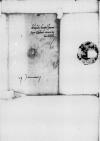List #1244
Bona Sforza do Ioannes DANTISCUSVilnius, 1534-12-06
| odebrano [1535]-01-02 Rękopiśmienne podstawy źródłowe:
Pomocnicze podstawy źródłowe:
Publikacje:
| ||||||||||||||
Tekst + aparat krytyczny + komentarz Zwykły tekst Tekst + komentarz Tekst + aparat krytyczny
Reverendo in paper damaged⌈[Reverendo in]Reverendo in paper damaged⌉ Christo Patri, domino Ioanni epi paper damaged⌈[epi]epi paper damaged⌉scopo Culmensi sincere nobis dilecto
Reverende in Christo Pater sincere nobis dilecte.
Misimus ad sacram
Dat(ae) or Dat(um)⌈Dat(ae)Dat(ae) or Dat(um)⌉
Ad mandatum sacrae paper damaged⌈[sacrae]sacrae paper damaged⌉ reginalis paper damaged⌈[lis]lis paper damaged⌉ maiestatis proprium paper damaged⌈[proprium]proprium paper damaged⌉


 BCz, 3465, p. 244
BCz, 3465, p. 244